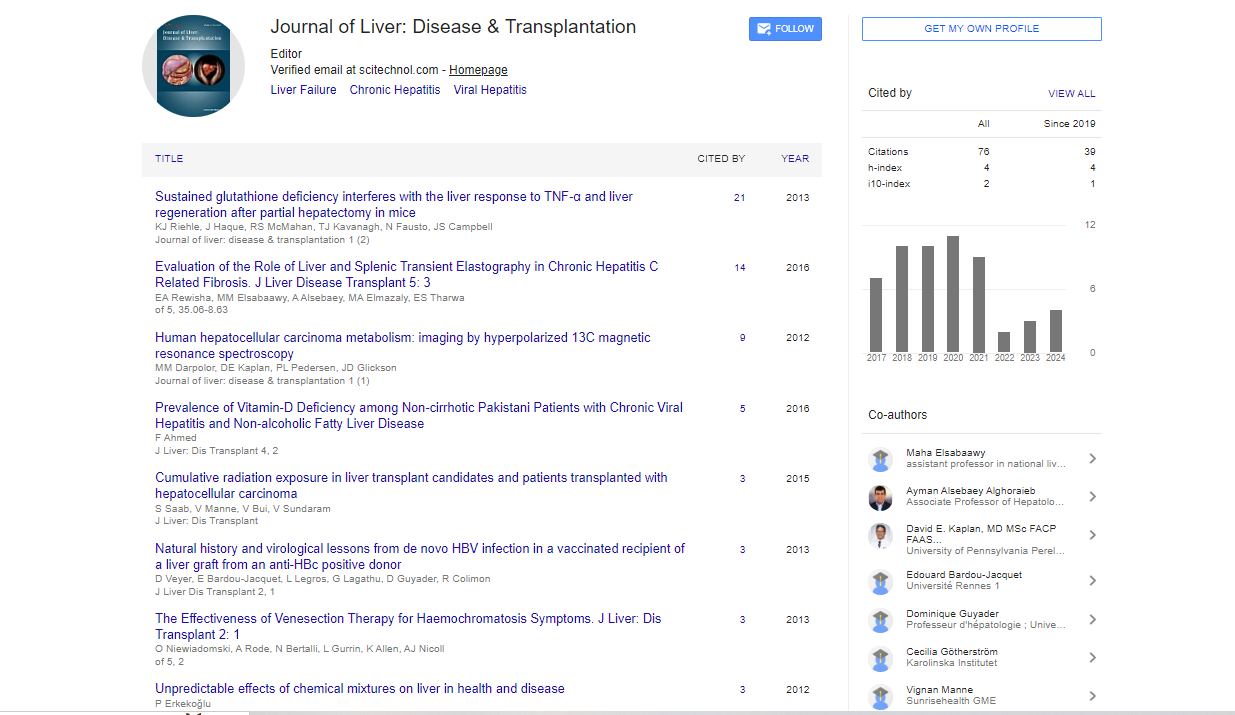Opinion Article, J Liver Disease Transplant Vol: 12 Issue: 4
Liver Sinusoids and their Vascular Vitality in Coordinating Liver Physiology
Shohei Jordi*
1Department of Histology and Embryology and Biomedical Center, Charles University, Pilsen, Czech Republic
*Corresponding Author: Shohei Jordi,
Department of Histology and Embryology
and Biomedical Center, Charles University, Pilsen, Czech Republic
E-mail: Jordi.sho@lfp.cuni.cz
Received date: 20 November, 2023, Manuscript No. JLDT-23-123862;
Editor assigned date: 22 November, 2023, Pre QC No. JLDT-23-123862 (PQ);
Reviewed date: 06 December, 2023, QC No. JLDT-23-123862;
Revised date: 13 December, 2023, Manuscript No. JLDT-23-123862 (R);
Published date: 20 December, 2023, DOI: 10.36648/2325-9612.100248
Citation: Jordi S (2023) Liver Sinusoids and their Vascular Vitality in Coordinating Liver Physiology. J Liver Disease Transplant 12:4.
Description
The liver, a remarkable organ with multifaceted functions, harbors an intricate network of vessels and structures essential for its diverse roles in metabolism, detoxification, and immune regulation. At the heart of hepatic microcirculation lies a unique and specialized vascular component known as the liver sinusoids. Liver sinusoids are microvascular channels intricately woven throughout the liver parenchyma. Comprising a labyrinthine network, these sinusoids facilitate the exchange of nutrients, metabolic byproducts, and immune cells between the bloodstream and hepatocytes—the primary functional cells of the liver. The sinusoidal endothelial cells form the inner lining of the liver sinusoids, featuring unique fenestrations. These fenestrations, or pores, permit the direct exchange of substances between the blood and hepatocytes, allowing for efficient nutrient uptake and waste removal. Scattered among the sinusoidal endothelial cells are Kupffer cells, specialized macrophages representing a vital component of the liver's immune system. These cells play a pivotal role in phagocytosing foreign particles, pathogens, and aged blood cells, contributing to the liver's immune surveillance function. It contains the extracellular matrix and various cell types, facilitating the dynamic interaction between blood and liver cells.
Liver sinusoids are the primary site for the exchange of nutrients between the blood and hepatocytes. As blood flows through the sinusoids, hepatocytes extract essential substances such as glucose, amino acids, and lipids, regulating systemic metabolic homeostasis. The liver plays a central role in detoxifying the bloodstream, and the sinusoids are integral to this process. Hepatocytes, in close proximity to the sinusoids, metabolize and neutralize toxins, drugs, and metabolic byproducts, preventing their accumulation and potential harm to the body. Hepatocytes lining the sinusoids are prolific producers of plasma proteins, including albumin, clotting factors, and enzymes. These proteins contribute to maintaining blood volume, transporting essential molecules, and ensuring proper coagulation. Kupffer cells stationed within the sinusoids serve as sentinels of the immune system. By monitoring the bloodstream for pathogens and foreign particles, these cells contribute to the liver's immune surveillance function, defending against potential threats. The liver receives a dual blood supply: the portal vein, carrying nutrient-rich blood from the digestive organs, and the hepatic artery, delivering oxygenated blood. The convergence of these two vascular inputs occurs within the liver sinusoids, creating a unique microenvironment for various physiological processes. The architecture of liver sinusoids imparts unique hemodynamic properties. Their wide diameters, fenestrations, and lack of a continuous basement membrane result in low vascular resistance and high compliance. This facilitates efficient blood flow and allows the liver to adapt to varying physiological demands. The flow of blood through sinusoids generates shear stress, influencing hepatocyte function. Shear stress contributes to the maintenance of hepatocyte polarity, influences cell signaling pathways, and plays a role in liver regeneration and metabolic responses.
Clinical implications
Cirrhosis, a progressive and irreversible condition, often alters the architecture of liver sinusoids. Fibrotic changes in the liver parenchyma can impede blood flow through sinusoids, leading to portal hypertension, compromised nutrient exchange, and increased risk of complications. This fibrotic transformation can distort the normal structure of liver sinusoids, impairing their function and contributing to the pathogenesis of liver diseases. Viral infections, particularly hepatitis viruses, can directly impact liver sinusoids. Inflammation and damage to sinusoidal endothelial cells can compromise nutrient exchange and disrupt the delicate balance of liver homeostasis.
Advancements in understanding the molecular mechanisms governing liver sinusoidal endothelial cells open new avenues for therapeutic interventions. Targeting specific receptors, signaling pathways, or fenestrations may offer novel strategies for modulating liver function in health and disease. Investigating the microcirculatory changes in liver diseases, including the alterations in blood flow dynamics and sinusoidal structure, provides valuable insights. Such study may unveil potential targets for interventions aimed at preserving or restoring hepatic function. The regenerative capacity of the liver, influenced by the dynamics of the sinusoidal microenvironment, remains a focus of regenerative medicine study. Understanding the factors governing liver regeneration holds promise for developing therapies that harness the inherent regenerative potential of the liver.
Conclusion
The liver sinusoids, with their intricate structure and diverse functions, embody the liver's extraordinary adaptability and resilience. Serving as a nexus for nutrient exchange, immune surveillance, and detoxification, these microvascular channels play a pivotal role in maintaining the intricate balance of hepatic homeostasis. As our understanding of liver sinusoids continues to deepen, the implications for clinical practice and therapeutic interventions expand. The dynamic interplay between blood flow dynamics, cellular components, and molecular signaling within the liver sinusoids provides a fertile ground for ongoing study. Exploring the marvels of hepatic microcirculation not only enriches our understanding of liver physiology but also holds the key to innovative approaches for managing liver diseases and advancing the field of hepatology.
 Spanish
Spanish  Chinese
Chinese  Russian
Russian  German
German  French
French  Japanese
Japanese  Portuguese
Portuguese  Hindi
Hindi 